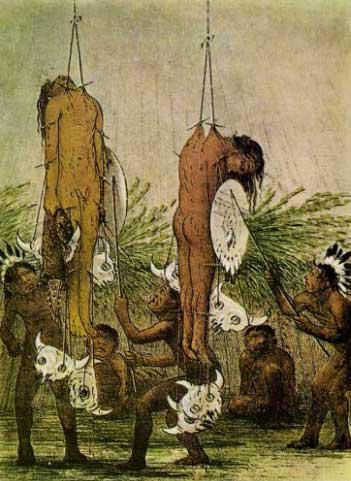In 1977, Stephen King published his short story “Children of the Corn” in Penthouse. Seven years later, movie audiences across the nation were horrified by the ritual doings of small town Nebraska kids who worshiped something malevolent in the corn.
It surely was no coincidence that later in the year, Nebraska experienced a sharp drop in tourism and state troopers issued record numbers of tickets to drivers in a hurry to pass through the state. Who can blame people for wanting to avoid scythe-wielding Corn Children with a pagan penchant for ritual murder:
You know things are bad when post-apocalyptic berserker Linda Hamilton (aka Sarah Connor) cannot avoid a corn crucifixion:

In “The Cultural Morphospace of Ritual Form: Examining Modes of Religiosity Cross-Culturally,” Atkinson and Whitehouse use the latter’s mode of religiosity theory to predict ritual forms. This theory proposes that two different kinds of cognitive memory systems — episodic and semantic — are linked to (and subserve) two broad categories of religion: “imagistic” and “doctrinal.”
The imagistic mode of religion is based on rare, climactic rituals that are extremely intense. The doctrinal mode revolves around frequently repeated rituals (or teachings) that are relatively sedate. The theory predicts that rituals associated with imagistic religions will be low frequency and high arousal, whereas rituals associated with doctrinal religions will be high frequency and low arousal.
To test these predictions the authors used a sample of 74 randomly selected societies drawn from the Human Relations Area Files, a well known and highly respected ethnographic database. They coded the rituals for frequency and arousal. As predicted, they found that ritual frequency is negatively correlated with ritual intensity. Ritual intensity levels were highest for once in a lifetime rituals and lowest for daily ones. There is a big arousal difference, in other words, between the Native American vision quest and attending Mass or performing Salah.
When the authors analyzed the variables associated with ritual intensity and arousal, they found that “reliance on agriculture is a key predictor of variation” and that agricultural intensity best predicts ritual intensity. Hardcore farmers prefer lowkey rituals. Hunter-gatherers, by contrast, tend towards the hardcore:

If this is the case, then religion-ritual variation (“imagistic” or “doctrinal”) might be better explained as a difference in political economy. The basic difference, in other words, is that pre-state and small-scale societies generally lack the kinds of elites, institutions, and technologies that promote “doctrinal” modes of religion. They also tend to lack writing and books, which may be prerequisites for “doctrinal” forms of religion.
We can also observe that until 10,000 years ago (i.e., before the Neolithic Revolution) all “religions” were shamanic and therefore imagistic. The domestication of plants and animals led to the development of city-states and resulted in a shift to more organized, systematic, and “doctrinal” forms of religion.
Thus while it may be true that “imagistic” religions draw primarily on episodic memory and “doctrinal” religions draw primarily on semantic memory, this cognitive association seems to be an historical effect rather than a biological cause. As Marx and Engels suggested long ago, a society’s mode of production generally determines its form of religion.
What does this have to do with deranged Corn Children? Assuming they planted the endless and eerie corn fields in the movie, we would predict their rituals to be mellow or even bookish. Ritual crucifixions and bloody murders don’t fit the predicted pattern. Either Stephen King missed the memo or he used the maize-loving Aztecs as his model.
Reference:
Atkinson, Quentin D., & Whitehouse, Harvey (2011). The Cultural Morphospace of Ritual Form: Examining Modes of Religiosity Cross-Culturally. Evolution and Human Behavior, 32 (1), 50-62 DOI: 10.1016/j.evolhumbehav.2010.09.002



